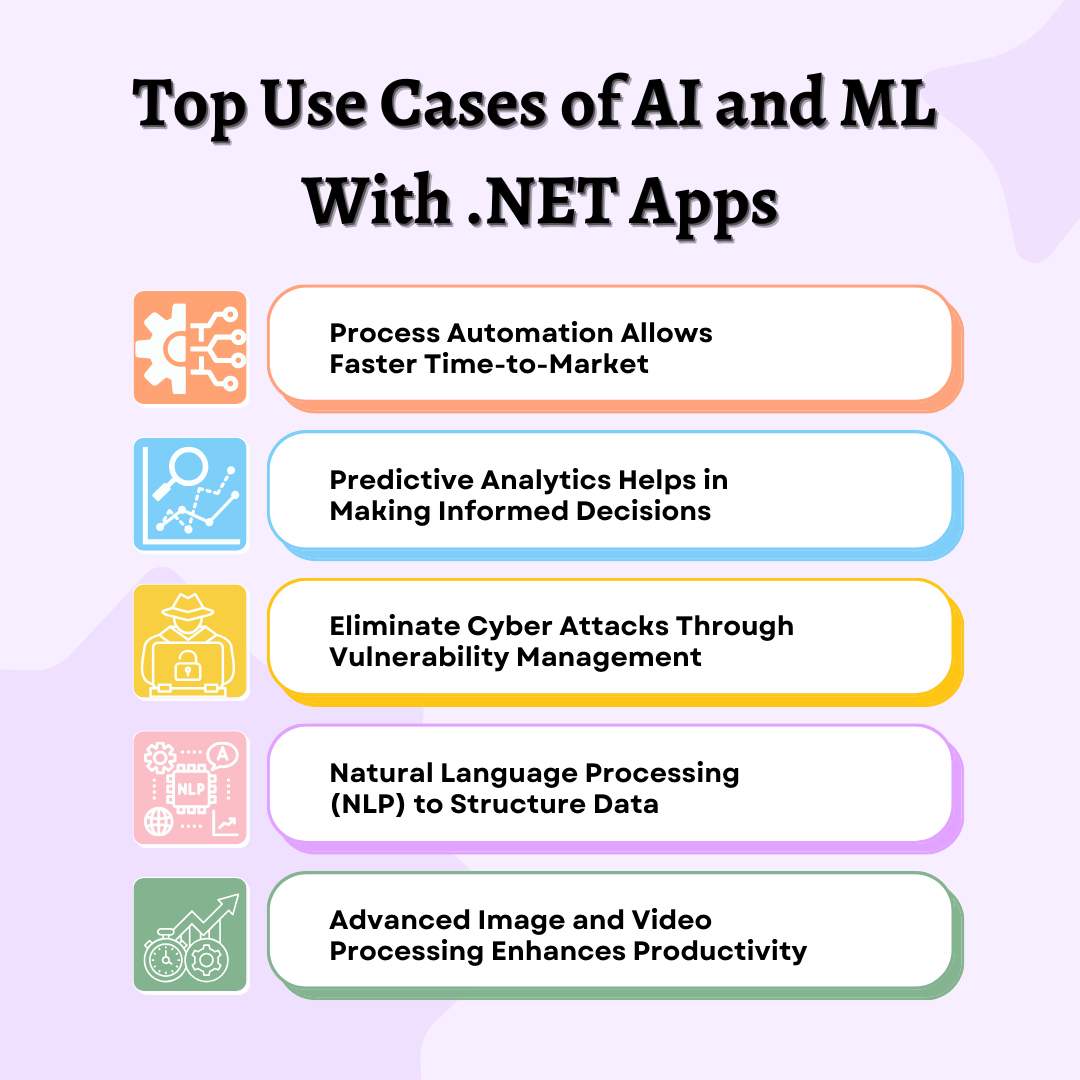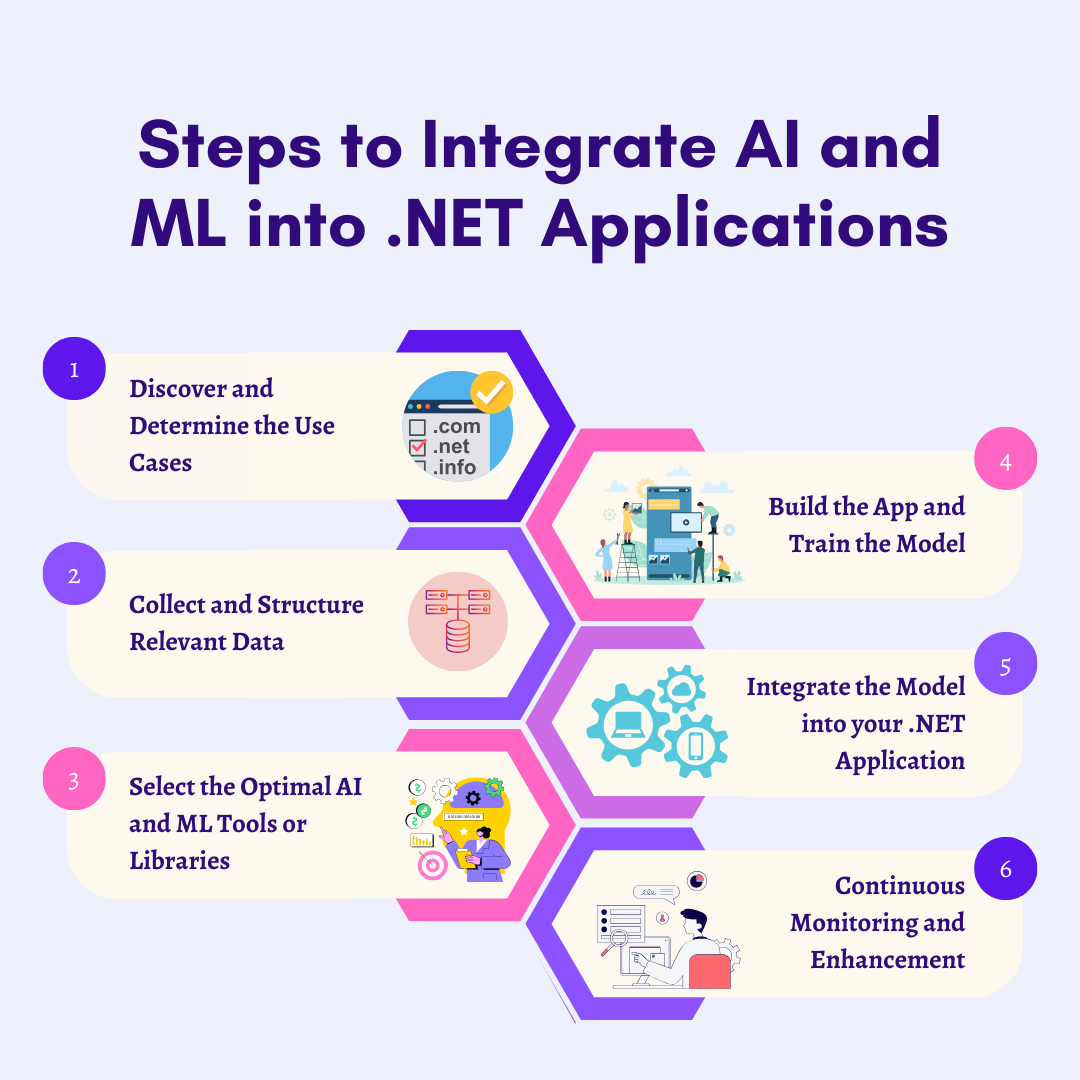Enterprises face many challenges in today’s competitive business environment, which can limit their productivity and growth. Organizations are under regular pressure to do everything from managing huge amounts of data to providing personalized client experiences. Thus, integrating machine learning (ML) and artificial intelligence (AI) with .NET apps can completely transform how businesses function.
For more than two decades, .NET apps have held a distinguished reputation in the business world. This is due to their remarkable attributes like speed, security, scalability, and stability. Organizations recognize the importance of AI-driven .NET applications and use ML Models in .NET Apps to address changing dynamics and reduce operational gaps.
Businesses are always looking for ways to improve decision-making, streamline operations, and remain ahead of the curve. The best solution is to hire .Net services provider to integrate AI and ML capabilities into a dot NET application. The best problem solution is incorporating AI and ML capabilities into a dot NET application. Enterprises can handle issues like data overload and process automation by utilizing the potential of AI and ML.
This .NET AI development guide will help you with the essential knowledge you need to meet the demand head-on. So, let’s embark on this digital transformation service with cognitive computing in .NET apps.
Why is there a Need to Shift to an AI/ML-enabled .NET Enterprise Infrastructure?
The need to transition towards an AI/ML-enabled .NET enterprise infrastructure is driven by various challenges plaguing businesses for years. These include handling massive data, making informed decisions, controlling operational efficiency, and dominating fiercely competitive marketplaces. AI/ML coupled with .NET, provides creative software solutions to tackle these issues.
AI/ML offers an advantage by having the power to customize customer experiences. Data-driven decision-making is made possible by AI/ML’s ability to sift through large datasets and produce useful insights. It reduces costs and errors by automating repetitive processes, improving operational efficiency, and predicting trends.
Moreover, AI/ML-powered .NET enterprise apps offer flexibility and scalability within the .NET framework. AI-driven threat detection strengthens cybersecurity, and sectors that require equipment maintenance can now use predictive maintenance.
Role of AI and ML in Enterprise-Grade .Net Applications

.NET AI solutions and machine learning development services are becoming pillars for new-age apps due to the following reasons:
-
Process Automation
ML and AI are the driving forces behind automation, mitigating errors in repetitive tasks and contributing to substantial cost savings. Beyond these benefits, ML and AI-powered .NET applications can orchestrate the control of various machinery and systems through a centralized database.
For instance: Transferring customer data from disparate systems to a unified, centralized server.
-
Predictive Analytics
With the integration of AI algorithms with .NET applications unlock the ability to detect intricate patterns within vast datasets and extract valuable insights. This synergy empowers businesses to anticipate the actions that a customer or user is likely to take .NET and predictive analytics become the linchpin for informed decision-making, enabling companies to prepare for both favorable and adverse outcomes proactively.
For instance: In eCommerce, businesses can accurately predict whether a customer is inclined to purchase a particular product or not.
-
Cyberattacks
Many forward-thinking organizations have harnessed the power of AI and .NET-based machine learning within their internal security applications. In these sophisticated software systems, ML models in .NET analyze data about security threats and potential attackers’ behavior. And then, the .NET development company steps in to leverage these insights, autonomously strengthening security measures.
-
Virtual Assistants and Chatbots
AI-driven Chatbots in ASP.NET and virtual assistants have become invaluable assets for enhancing user engagement and elevating customer satisfaction rates. And it also helps in saving money, as businesses don’t have to invest heavily in hiring support staff.
For Instance: These chatbots and conversational AI in .NET can recognize and dissect user queries, providing precise solutions with predefined guidelines.
This seamless process satisfies customers and increases web traffic, ultimately driving business success. You can seek guidance from a reputable chatbot development company to integrate AI-powered web applications with .NET.
Also Read | Building an AI-Powered Medical Chatbot in 2023
-
Natural Language Processing (NLP)
.NET applications can acquire a human-like understanding of spoken language and written text when you embed AI and ML.
Apps for the .Net assess human speech via text or voice data by combining computational linguistic rule-based modeling of human speech with statistical, ML, and deep learning techniques.
-
Advanced Image and Video Processing
Numerous forward-thinking enterprises have enhanced the functionalities and capacity of image recognition in .NET applications by harnessing the transformative potential of deep learning technologies and refining Convolutional Neural Network (CNN) models.
.NET framework has ushered in a host of image and video processing advancements. These include image/video enhancement, restoration, precise segmentation, efficient compression, object detection, image manipulation, new visual content, and seamless image-to-image translation.
You can consult with an MVP development company to discuss your .NET-based app idea to check the viability of your project.
How To Integrate AI and ML into .NET-based Enterprise Products

A well-structured approach is essential to building intelligent apps with ML.NET and AI. You must follow the below-mentioned process:
1. Discover and Determine the Use Cases
The first step to initiate your AI and ML integration is to define the project’s objectives and goals. This initial phase provides invaluable clarity on the precise use case of your .NET application.
For example, you will know whether you need integration of ML or AI for chatbots, virtual assistants, image processing, decision support, automation, or any other application. A well-defined purpose sets the stage for a successful model deployment in .NET
2. Collect and Structure Relevant Data from Various Sources
Training the Model before deploying a .NET machine learning integration in a real-world scenario is crucial. So, you must gather and organize diverse datasets for the ML apps.
It’s imperative to thoroughly validate the data, scrutinizing not only for factual correctness but also for relevance, currency, and precision.
3. Select the Optimal AI and ML Tools or Libraries
The pivotal next step is the selection of a suitable ML and .NET AI development framework, toolkit, or library that aligns seamlessly with your use case. ML.NET, ONNX, CNTK, TensorFlow, and PyTorch are the top libraries/.NET framework for machine learning that most .NET developers prefer for their distinct capabilities.
However, before selecting, you must partner with a custom ASP.NET development service provider to ensure your hardware and software resources are fully equipped to prevent potential challenges.
4. Build the App and Train the Model
With the library or framework in place, AI or ML model training is the next vital phase. During the training, give substantial volume of inputs to the models and record their outputs. It’s essential to scrutinize the results and update the data to fine-tune the models, ensuring they deliver the anticipated predictions.
Your generative AI development company will also begin integrating AI services in ASP.NET. Rigorous testing across diverse devices is imperative; it ensures the application operates seamlessly and precisely as intended.
5. Integrate the Model Into Your .NET Application
After completing AI/ML model training and receiving anticipated outcomes, start deep learning integration with .NET application. Your .NET AI services provider can seamlessly link communication between your AI/ML model and the .NET software through a suitable API.
Furthermore, AI development services will test the compatibility, overall functionality, and performance. This step is paramount, ensuring that the integrated components operate as intended.
6. Continuous Monitoring and Enhancement
Post-deployment, constantly monitor your .NET application health, performance, and speed to provide a seamless user experience. If any bugs or vulnerabilities surface, patch them before exploitation.
Furthermore, a proactive approach entails regularly feeding your Model with fresh data, ensuring its ongoing relevance and the delivery of enhanced outputs.
Also Read | How is AI Revolutionizing Mobile App Development?
What are the Prominent .NET Frameworks and .NET Core AI and ML Libraries?
You must develop and train their models to integrate AI and ML in a .NET app. Moreover, for the .NET core for AI Development, you should know the relevant .NET compatible libraries and frameworks.
1. TensorFlow
TensorFlow is a premier open-source library that seamlessly infuses ML and AI into .NET applications. It provides you with a pre-trained model, simplifying the process of installation and immediate utilization. It also adjusts to different deployment patterns, such as cloud-based AI services for .NET and web browsers, device-based apps, and on-premises installs.
2. ML.NET
It is an open-source framework designed specifically for .NET applications. It’s a Microsoft product, and one can download it from the official website for free.
3. CNTK (Cognitive Toolkit)
The Microsoft Cognitive Toolkit is a powerful library that helps build neural networks for regularly training ML algorithms. When you hire machine learning developers, they utilize it to elevate the functionality and enable applications to delve into intricate predictive analysis. It also caters to both low and high-level APIs within applications.
4. PyTorch
After collaborating with Facebook, Microsoft has introduced integration and robust support for PyTorch—an open-source machine learning framework. AS a dot NET developer, it can facilitate the quick implementation and training of ML.NET-based models. PyTorch streamlines data processing, allowing applications to scale and be flexible.
5. Accord .NET
Accord.NET is an efficient ML framework for .NET apps. Many .NET app developers prefer it over other frameworks because of its built-in image and audio processing capabilities. Moreover, the framework is crafted using C#, aligning seamlessly with the .NET ecosystem and its components. You can hire C# Developers to build an intuitive .NET software.
Also Read | A Comprehensive Guide to MVP Development Cost
Enterprise AI Vendor and Tools Market
The enterprise AI vendors and tools ecosystem encompasses a wide array of capabilities related to AI and ML. Major cloud AI platforms like AWS, Google, IBM, and Microsoft offer a comprehensive suite of tools for developing and deploying AI applications. These platforms are particularly advantageous for enterprises with a significant cloud presence on one specific platform. You can hire .Net developers to embed specific tools to build interactive apps.
Within these cloud providers’ product offerings, there are typically two tiers. The first tier comprises Data Science and Machine Learning (DSML) platforms primarily designed for data scientists. The second tier encompasses low-code modules catering to a broader user range.
For instance, Microsoft’s Azure AI offers robust tools, while Azure Cognitive Services provides pre-built AI modules. AWS boasts Amazon SageMaker, a managed machine learning service for constructing production-ready AI pipelines, alongside AI services accessible without requiring extensive machine learning expertise.
Why Choose SparxIT for Developing AI and ML-based .NET Applications?
Selecting SparxIT to integrate AI and ML with .NET apps is a strategic choice driven by our unparalleled expertise in .NET Framework and AI. We have vast experience in AI model deployment in .NET and machine learning development services to create scalable, future-proof solutions. Our team is well-versed in the intricacies of ML.NET Integration, ensuring seamless and optimal performance.
Our commitment to custom, client-centric solutions that meet specific business needs sets us apart. With SparxIT, you gain a competitive advantage through the convergence of AI, ML, and .NET, underpinned by our unwavering commitment to excellence.
Conclusion
In the ever-evolving world of software development, continuous innovation is the hallmark of progress. The most significant trend making waves in this troposphere is the integration of AI and ML in .NET Core Projects. It provides several benefits, serving both businesses and end-users. AI and ML’s transformative capabilities enhance performance, automating routine tasks, streamlining workflows, and providing invaluable predictive insights.
Personalization using AI in .NET elevates user experiences and real-time analysis of data. Furthermore, these technologies boost productivity by liberating resources for more strategic tasks and eliminating the need for manual data entry. The result? You will get custom AI solutions with .NET applications that are efficient and productive, driving business growth.
Are you considering the integration of AI and ML within your .NET applications? Connect with an innovation-intensive ASP.NET development company that can empower your apps to be more proactive and intelligent.
Frequently Asked Questions
Q: What are the key advantages of integrating AI and ML into .NET applications?
A: AI and ML integration in .NET apps can enhance automation, analytics, personalization, and fraud detection, improving the application’s capabilities.
Q: What are the industries where AI and ML integration with .NET has been successful?
A: Industries like healthcare, finance, and e-commerce have successfully leveraged artificial intelligence and machine learning in .NET for medical diagnosis, fraud prevention, and recommendation systems.
Q: How much does integrating AI and ML into .NET apps cost?
A: The cost of integrating AI and ML with intelligent .NET apps can differ significantly. It depends on factors like data acquisition, model training, and deployment requirements. It’s essential to consult with applications development firms to determine a precise budget.
Q: What are the challenges when implementing AI and ML in .NET applications?
A: Challenges include data quality, model selection, and computational resources. Careful planning and data preprocessing are necessary for building intelligent .NET solutions.





